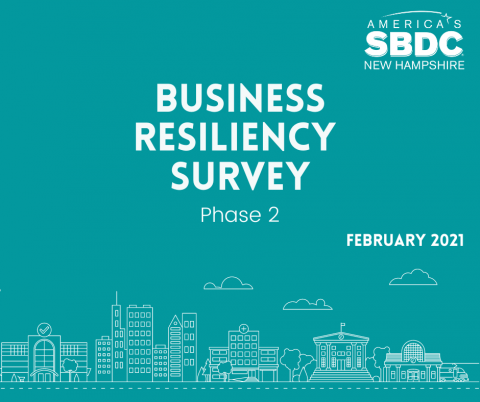
We are pleased to work with the UNH Survey Center and 56 partner organizations to run the NH SBDC Business Resiliency Surveys to discover current and lasting effects of the COVID-19 pandemic on the Granite State's small businesses. Hearing from business owners like you helps SBDC and other economic development organizations to better understand your challenges and needs going forward. By leveraging the results of the surveys, we can more effectively assist in the state's recovery efforts.
Key Findings from Phase 2 of the Business Resiliency Survey may be found here.
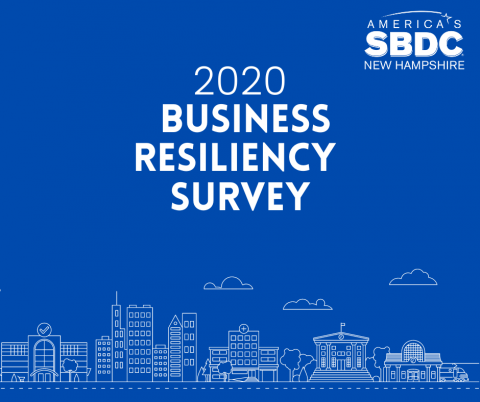
Phase 1: The University of New Hampshire Survey Center conducted a survey for the NH Small Business Development Center (SBDC) to assess the impact of COVID-19 on small businesses throughout New Hampshire. By better understanding the challenges and needs of NH business owners, economic development partners can more effectively help businesses recover, reopen and become more resilient.
Fifty-six business organizations partnered with the SBDC by sending an open-link email invitation to participate in the survey to their member businesses. The survey partners represented a wide range of industries, business associations and regions. They were encouraged to send periodic reminders to potential respondents. Overall, 1,549 participants from 172 towns and cities completed the survey between June 10 and June 24, 2020.
It is important to remember that while the survey was open, the state of New Hampshire was transitioning from the Stay at Home 2.0 order to the Safer-at-Home order. Businesses were adjusting to state reopening guidelines. In addition, the federal and state relief programs available at the time of the survey were: Paycheck Protection Program (PPP), Economic Injury Disaster Loan (EIDL) and EIDL Advance, Main Street Relief Fund, WorkShare, Pandemic Unemployment Assistance (PUA) (for self-employed, business owners, employees), along with regional and local programs. Depending on whether a business had received support from one or more of these programs prior to responding to the survey may determine how questions were answered.
The NH SBDC 2020 Business Resiliency Survey was made possible with funds from the CARES Act.
NH SBDC phase 1 Business Resiliency Survey Report
The survey results were presented to economic development partners on 7/13/2020. Watch the presentation on YouTube.
Key Findings
Just under half of respondents say their business was deemed essential by Governor Sununu's emergency order while a similar number were deemed to be non-essential and closed; a small number were deemed to be essential businesses but closed voluntarily. Larger businesses were more likely to have been declared an essential business. Those that chose to close most often did so because of health and safety concerns.
The average respondent's business has just under eighteen employees, down slightly from mid-February, when the average business had a reported average of twenty-two employees. However, a majority of respondents say their business currently employs fewer than ten people. More than four in ten respondents say their business employs fewer people than it did in February.
More than three-quarters of respondents say their business has seen its monthly revenue decrease as a result of COVID-19 and nearly half say their revenue has fallen by 50% or more. Businesses with very few employees, those in the arts, entertainment, and recreation industry or the accommodation and food service industry, and those deemed non-essential were particularly likely to lose more than 50% of their revenue. Respondents most frequently cite a decline in sales, reduced hours of operation, and being required to close as the primary factors that have impacted their business's finances, with a decline in sales clearly the most important factor.
The Payroll Protection Program was by far the most commonly utilized federal relief program; six in ten respondents say their business used it, while about a quarter utilized an Economic Injury Disaster Advance or Loan. Among state, municipal, and private relief programs, four in ten respondents used the Main Street Relief Fund and about a quarter utilized unemployment for their employees or for themselves. SELF (Self Employment Livelihood Fund) was not yet available.
Although only one in five respondents say their business had a resiliency or continuity plan prior to the COVID-19 pandemic, 73% said that resiliency planning will be very important or somewhat important to their business in the future. Larger businesses and those involved in manufacturing, health care, or social assistance are more likely to have had such a plan.
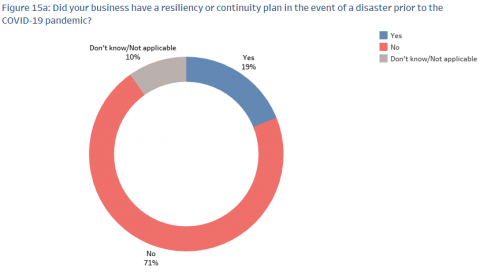
Figure 15a
Nineteen percent of respondents say that their business had a resiliency or continuity plan in the event of a disaster prior to the COVID-19 pandemic. Seventy-one percent of respondents did not have a resiliency or continuity plan while 10% don't know or say the question is not applicable. Despite only one-fifth of respondents saying that their business had a resiliency or continuity plan prior to the pandemic, nearly three-quarters think that resiliency planning will be very or somewhat important to the future of their business.
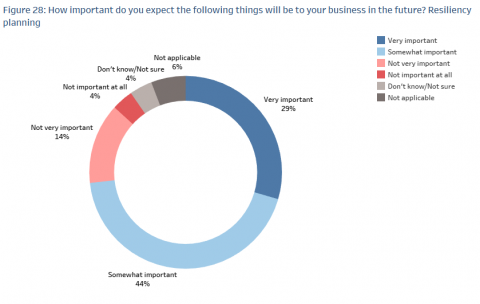
Figure 28
Nearly three-quarters (73%) of respondents believe resiliency planning will be very (29%) or somewhat (44%) important to their business in the future. Fourteen percent believe it will be not very important and only 4% believe it will not be important at all. Four percent don't know or are unsure how important this will be to their business while 6% say this is not applicable to them.
As a result of COVID-19, four in ten have maintained or brought employees back under the Payroll Protection Program. Less than a quarter have laid off and furloughed employees, while about the same number currently have employees working remotely. Also, just under half of respondents say their business purchased personal protective equipment for their employees.
Respondents also reported innovations and modifications that their business has implemented due to COVID-19, with more than a quarter having made physical changes to their location, having had employees work from home, or having started offering new products or services. About one in five say because of COVID-19 they are now collaborating with other businesses, engaging in e-commerce, or offering curbside delivery.
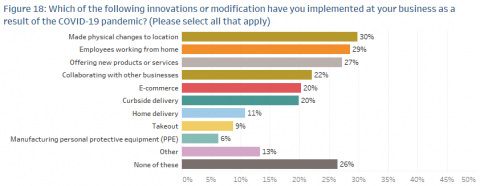
Figure 18
As a result of the COVID-19 pandemic, more than a quarter of respondents say their business made physical changes to their location (30%), have employees now working from home (29%), and are offering new products or services (27%), while just under a quarter are collaborating with other businesses (22%), engaging in E-commerce (20%), or offering curbside delivery (20%) as a result of COVID-19. Fewer respondents say their business now offers home delivery (11%) or takeout (9%) or say that their business is now manufacturing personal protective equipment (PPE) (6%). Thirteen percent say their business has implemented another innovation or modification as a result of the pandemic while 26% say their business has done none of these things.
When asked about one successful thing their business has done in response to COVID-19, respondents most frequently mention that they changed how they deliver or produce their products, that they implemented remote or virtual work, that they protected the health of employees or customers, or that they practiced better external communication or advertising.
Maintaining sales and revenue and maintaining customers are by far the biggest concerns of respondents as their businesses recover from COVID-19; more than four in five respondents say they are very or somewhat concerned about these things. Majorities are also concerned about timely payment of bills, access to capital, supply chain disruptions, liability with following CDC and health guidelines, and cleaning the work environment. Few respondents say that they are concerned about access to COVID-19 testing, defaulting on existing loans, or working remotely as their business recovers.

Figure 20
The vast majority of respondents (92%) say that they are very (71%) or somewhat (21%) concerned about maintaining sales/revenue as their business recovers, while 85% are very or somewhat concerned about maintaining customers. A majority of respondents are very or somewhat concerned about timely payment of bills (66%), access to capital (61%), supply chain disruptions (57%), liability with following CDC and health guidelines (54%), and cleaning the work environment (52%) as their business recovers. Less than half of respondents are concerned about access to personal protective equipment (PPE) (46%), being forced to lay off or furlough employees (45%), energy costs (44%), bringing back employees (41%), cybersecurity (40%), delayed hiring of new employees (38%), access to COVID-19 testing (38%), or defaulting on existing loans (32%), while only 17% are concerned about working remotely as their business recovers. Thirty-five percent are very or somewhat concerned about something else as their as their business recovers.
Less than half of respondents are concerned about access to personal protective equipment (PPE) (46%), being forced to lay off or furlough employees (45%), energy costs (44%), bringing back employees (41%), cybersecurity (40%), delayed hiring of new employees (38%), access to COVID-19 testing (38%), or defaulting on existing loans (32%), while only 17% are concerned about working remotely as their business recovers. Thirty-five percent are very or somewhat concerned about something else as their as their business recovers.
Most businesses plan to continue the changes and innovations they made in response to COVID-19 even after the pandemic has passed; more than four-fifths of those who have implemented e-commerce, collaborated with other businesses, or offered new products or services and majorities of those who now offer takeout, have employees working from home, made physical changes to their location, or offer curbside or home delivery plan to continue doing so.
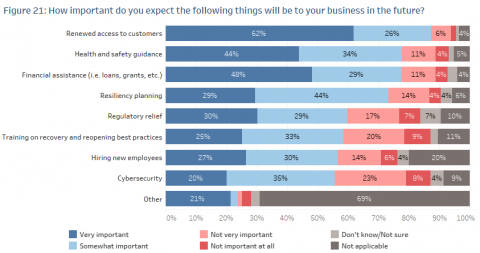
Figure 21
Seven in eight (87%) respondents expect renewed access to customers will be very (62%) or somewhat (26%) important to their business in the future while 78% believe health and safety guidance will be very or somewhat important, 77% say financial assistance will be very or somewhat important, and 73% believe resiliency planning will be very or somewhat important to their business in the future. Over half of respondents believe that regulatory relief (60%), training on recovery and reopening best practices (58%), hiring new employees (57%), or cybersecurity (56%) will be very or somewhat important to their business in the future, while 24% mention something else they believe will be very or somewhat important.
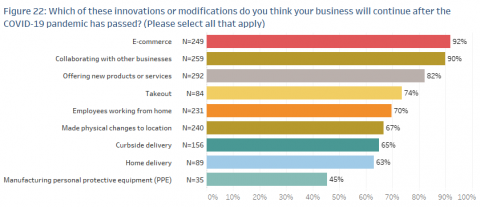
Figure 22
Respondents indicate that four-fifths or more of businesses which have implemented e-commerce (92%), collaborated with other businesses (90%), or offered new products or services (82%) plan to continue to do so after the COVID-19 pandemic has passed. Majorities of those who now offer takeout (74%), have employees working from home (70%), made physical changes to their location (67%), offer curbside delivery (65%), and offer home delivery (63%) plan to continue doing these things after the pandemic has passed, while 45% of those who have been manufacturing personal protective equipment plan to continue to doing so.
Most respondents are confident that their business will continue operating in the short term, but about one in six say they are not very or not at all confident that their business will be operating twelve months from now. In terms of the wider recovery, few respondents expect that the state economy will recover to pre-pandemic levels within three months. Respondents are more bullish in their outlook for the state economy in twelve months, as six in ten expect a recovery to pre-pandemic levels by then, but one-third are dubious that this will have occurred even within twelve months.
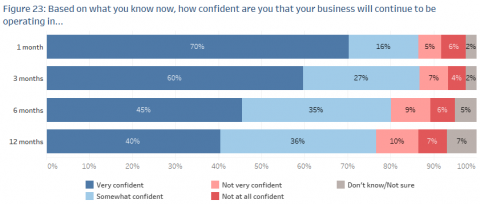
Figure 23
Most respondents are very or somewhat confident that their business will be operating in one month (86%) and in three months (87%). However, slightly fewer residents say they are very or somewhat confident they will still be operating in six months (80%) or in twelve months (77%), with about one in six saying they are not very or not at all confident they will still be operating in that time.
Overall, 1,549 businesses from 172 towns and cities responded to the survey. These businesses represented a wide variety of industries and sizes.
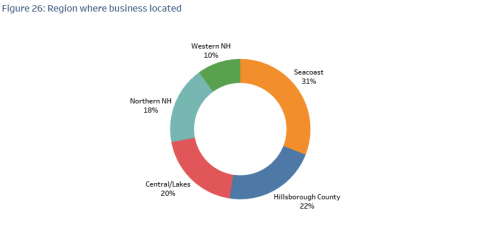
Figure 26
Overall, businesses from 172 towns and cities in New Hampshire responded to the survey. Thirty-one percent of these respondents say their business is located in the Seacoast region, 22% are located in Hillsborough County, 20% are located in the Central/Lakes Region, 18% are located in Northern NH, and 10% are located in Western NH.

Figure 25
A map showing where businesses are located in New Hampshire.

Figure 27
Thirteen percent of respondents say their business is in the retail trade industry, 11% are in the accommodation and food services industry or the arts, entertainment, and recreation industry, 10% are in the health care and social assistance industry or the professional, scientific, and technical services industry, and 7% are in the manufacturing industry. Fewer respondents say their business is in the educational services (4%), construction (4%), finance and insurance (2%), wholesale trade (2%), real estate rental and leasing (2%), transportation and warehousing (1%), information (1%), administrative support, waste management, and remediation (1%), or agriculture, forestry, fishing, and hunting (1%) industries. Twelve percent say their business belongs to another type of industry while 6% say their business is part of another type of services.
The downloadable abridged pdf report is available here:
NH SBDC 2020 Business Resiliency Survey
If you would like a link to the full report, please email nh.sbdc@unh.edu with your request.
Watch the survey results presentation (7/13/2020)on YouTube.
Thank you to our Survey Partners
- U.S. Small Business Administration - NH District Office
- NH Department of Business & Economic Affairs
- UNH Peter T. Paul College of Business & Economics
- NH Regional Development Corporation Alliance
- Center for Women & Enterprise
- SCORE
- USDA Rural Development
- UNH Cooperative Extension
- UNH Center for Family Enterprise
- UNH Innovation
- Arts Alive
- Associated General Contractors of NH
- Clean Energy NH
- CoHo
- Goldman Sachs 10,000 Small Businesses
- Hannah Grimes Center
- HRKNSS
- League of NH Craftsmen
- NH Aerospace & Defense Export Consortium
- NH Association of Chamber of Commerce Executives
- NH Auto Dealers
- NH Business & Industry Association
- NH Businesses for Social Responsibility
- NH Coalition of Wedding Vendors
- NH Grocers Association
- NH Lodging & Restaurant Association
- NH Made
- NH Manufacturing Extension Partnership
- NH Retail Association
- NH State Council on the Arts
- NH Tech Alliance
- State Early Learning Alliance
- Town of Derry
- Wentworth Economic Development Corporation
- Greater Claremont Chamber of Commerce
- Greater Concord Chamber of Commerce
- Greater Derry Londonderry Chamber of Commerce
- Greater Dover Chamber of Commerce
- Exeter Area Chamber of Commerce
- The Falls Chamber of Commerce
- Hampton Area Chamber of Commerce
- Hooksett Chamber of Commerce
- Greater Hudson Chamber of Commerce
- Kearsarge Area Chamber of Commerce
- Greater Keene Chamber of Commerce
- Lakes Region Chamber of Commerce
- Lakes Sunapee Region Chamber of Commerce
- Greater Manchester Chamber of Commerce
- Meredith Area Chamber of Commerce
- Greater Nashua Chamber of Commerce
- Northern Gateway Chamber of Commerce
- Greater Peterborough Chamber of Commerce
- Greater Pittsfield Chamber of Commerce
- Chamber Collaborative of Greater Portsmouth
- Greater Rochester Chamber of Commerce
- Souhegan Valley Chamber of Commerce
